
LOS ANGELES
A winter storm that powered its way through California was reduced to scattered showers on Tuesday, leaving behind a few mudslides and traffic snarls but no major damage.
The low-pressure system was expected to move northeastward, but the National Weather Service said a chance of snow and rain remained through the afternoon. In the Sierra Nevada, a storm warning was in effect until 4 p.m.
In coastal Monterey County, mudslides closed Highway 1 for most of the morning. The closure came shortly after a flash flood warning was issued for the Big Sur area and other parts of the county. The route reopened about 11 a.m.
Numerous traffic accidents were reported on wet roads and two people were killed in crashes in Ventura County, the California Highway Patrol reported.
A morning rock slide on a railroad track in Ventura County delayed a Metrolink commuter train nearly two hours.
In Los Angeles, a warehouse roof partially collapsed Tuesday morning. The building was flooded but nobody was hurt, said Fire Department spokeswoman d’Lisa Davies.
The rain, which began Sunday, renewed fears of mudslides in areas ravaged by wildfires last year, but only a few minor messes occurred. In Orange County, mud flowed over sandbags and seeped into about 20 homes in Yorba Linda on Monday, and muddy runoff plagued some parts of the foothill city of Sierra Madre east of Los Angeles.
Southern California mountains got 1 feet to 2 feet of snow and the total could top 3 feet at higher elevations, National Weather Service meteorologists said.
The storm came amid a dry winter in Southern California. Downtown Los Angeles saw a little over 1 inch of rain since Sunday, said Stuart Seto, a NWS weather specialist in Oxnard.
Tallying of seasonal rainfall began July 1 and since then about 8.21 inches of rain have fallen in the downtown area, leaving Los Angeles about an inch behind its annual average of 9.23 inches to date, Seto said.
Seto said the new rainfall will help restore moisture to local groundwater and crops, but the overall effect on the statewide drought will be minimal.
The storm “won’t help that much because it added water to some of our local reservoir and groundwater systems, but the drinking water we depend on year round comes out of the Sierra Nevada,” Seto said.
The California Department of Water Resources reported at the end of January that the Sierra snowpack was only about 61 percent of normal.









